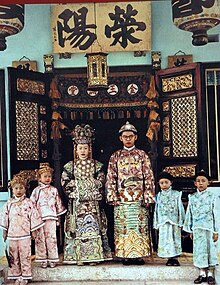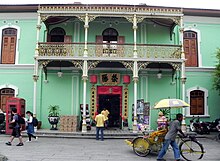Baba-Nyonya

The Baba-Nyonya or Peranakan are an ethnic group living in Malaya that originally emerged from the union of Malay women and Chinese men. The Chinese men had emigrated to Malaya as wage laborers.
Baba denotes a male member of this group, Nyonya a female. Baba-Nyonya and Peranakan are synonymous collective names. They are also called Straits Chinese (after the Straits of Malacca ). The word “Peranakan” is also used to denote Indonesians of Chinese descent. In both cases, "Peranakan" denotes descendants of parents of different ethnicities.
Through these intercultural marriages , a society was formed that was shaped by Sinomalay culture. The culturally predominant Chinese element was permanently retained, as in the following generations marriages were mostly concluded within the ethnic group or with Chinese.
Most Peranakan have Hokkien ancestry; some are descended from Teochew and Cantonese . Records from the 19th and early 20th centuries indicate that young Peranakan men typically sought their bride within the local Peranakan community. Peranakan families also often brought young women from China to marry or sent their daughters to China to find husbands. Based on the Malay-Chinese mixture, the Chinese element should be strengthened.
In the multicultural Malaysian society, the Malay element is said to dominate, subsidized by the state. In return, this leads to a segregation of the Chinese and Indian minority ethnic groups: Although they live together in one state, the groups are sometimes also separated. The Malaysian society is therefore not a uniform mixed culture, but rather the individual groups live side by side and tolerate the presence of "the other" reasonably peacefully.
This is even more sharply defined in Indonesia: there, for example, the use of Chinese characters was simply prohibited for a long time.
There is also a small group of Indian Peranakan known as the Chitty: their group is a mix of Chinese and Indian ethnicities.
history
Although the Baba-Nyonya society did not develop until the end of the 19th century , the Chinese settlement in Malaya has a long history:
In the late Tang Dynasty (618–907) and early Song Dynasty (960–1279), the first Chinese traders from Fujian settled in Malaya. In the Yuan Dynasty (1279-1378) their home port Xiamen reached its zenith as China's main port. There were birds' nests (a delicacy), tin , rattan , Betelwachs and other products of Malaya traded.
In the Ming Dynasty , foreign trade was outsourced to Guangzhou in Guangdong Province . However, the Hokkien continued to trade illegally, and their overseas settlements began to detach themselves from China.
In the 15th century, the city-states of the Malay Peninsula often paid tribute to China and the King of Siam / Thailand. In response to these tribute payments, the Sultan of Malacca was once sent a Chinese princess. The servants who accompanied the princess expanded in the descendants to Straits-born Chinese.
The Peranakan retained most of their ethnic and religious origins but adopted the language and culture of Malay. They developed a unique culture and their own cuisine. Many sources claim that the early Peranakan mingled with local Malay populations, but the lack of physical features suggests to many experts that the Chinese ethnicity is quite hollow. The Peranakan often sent their sons and daughters to China to find spouses. In the early 1800's, more Chinese immigrants added to the Peranakan population.

The religion of the Malays, Islam, also forbade marriage without the spouse's previous conversion to Islam. The world of thought of Islam, however, is largely remote from the Chinese. Thus, young people with a cultural Chinese background found it difficult to find a Malay partner for marriage.
By the mid-twentieth century, most of the Peranakan were also trained in English as a result of British colonization. Because the Peranakan quickly adopted the English culture, high administrative tasks were often given to Straits Chinese or Peranakan. Interaction with the English also prompted a number of Peranakan to convert to Christianity. In particular, the Chinese population in North Borneo is largely Christian.
The Peranakan became very influential in Malacca and Singapore, and became known as "the King's Chinese" for their proven allegiance to the British Crown. Because of their varied interactions with different languages and cultures, most Peranakan were able to communicate in three languages with the Chinese, British and Malay by the middle of the twentieth century.
Their usual occupations were merchants, traders, and generally intermediaries between China, Malaya and the West. The latter was particularly valued by the British because the Babas also had good relations with the Malay and acted as advisors at the Malay sultan's courts. In fact, the term "Baba" is an honorable Malay word, probably derived from Hindi / Sanskrit : Baba means grandfather or father, and is used as a word of adoration and affection for an elderly gentleman. In the same way, Nyonya is the kind word for grandmother. In this respect, older people would be more correctly designated with “Baba-Nyonya”, while “Peranakan” is more general.
During the British colonial era, the Peranakan / Baba-Nyonya were the most influential group because of their economic superiority. Since it was strongly promoted by the colonial power, they were often politically active against the Malays.
Today the Peranakan / Baba-Nyonya integrate more and more into the community of overseas Chinese resident in Malaysia and Singapore , which means that they lose their cultural independence more and more. At the same time, however, certain parts of their culture are promoted by the state, as they are understood as an essential part of Malaysian and Singaporean history. The Peranakan Museum in Singapore presents the whole spectrum of the Peranakan culture.
language
Their language, Baba Malay [Bahasa Melayu Baba], is a dialect of the Malay language that contains many Hokkien words. It is a dying language and contemporary use is limited to the elderly. This also applies to the Peranakan culture as a whole.
In Singapore, Peranakan are ethnically classified as Chinese by government policy. Because upbringing is based on ethnicity, apart from English in a second language (called “mother tongue” there), they are required to learn Mandarin instead of the Malay-dominated language Baba Malay in the families. In Malaysia, on the other hand, the standardization of the Bahasa Melayu Malaysia language, which is compulsory for all ethnic groups, has gradually led to the disappearance of the unique characteristics of Baba Malay.
Culture
The culture of the Peranakan or Baba-Nyonya is shaped equally by Chinese and Malay elements. Everyday life, such as language and cuisine, is dominated by Malay elements, while Chinese traditions have been preserved in relation to religion and important customs such as weddings, funerals and ancestor worship . Due to the earlier spatial isolation of the individual communities, there are also large differences between the local characteristics.
The Baba-Nyonya are now sometimes seen as the "first Malaysians" or the "first Singaporeans", especially by groups that want to emphasize the multicultural orientation of the states. At the same time, however, the assimilation of the Baba-Nyonya into the community of overseas Chinese is increasing , which will presumably lead to an extinction as an independent group, even if some cultural elements are preserved.
Historical-cultural objects of Baba culture are exhibited in cultural houses on Heereen Street and Jonker Street in Malacca and Penang and in the Peranakan Museum in Singapore . There you can see furniture, food items and also traditional clothing. There are also a small number of "Nyonya" restaurants in Singapore, Penang, Malacca, and on the west coast of Malaysia.
The Peranakan partly assimilated to the Malay culture, especially in the diet, clothing and language, while on the other hand they kept some Chinese traditions (religion, naming and ethnic identity), thus achieving a cultural fusion of its own. In particular, the Malay influence developed into an independent cuisine with the spices of Malay cuisine. Examples are “Chicken Kapitan”, a chicken curry dish, and “Inchi Kabin”, a Nyonya version of baked chicken.
The women, the nyonyas, began to wear the baju kebaya , a Malay clothing best known in the West as the attire of the stewardesses of Malaysia and Singapore Airlines .
In any case, most of the Peranakan are not Muslims, they have kept the tradition of the Chinese from ancestors, although some converted to Christianity. The wedding ceremony is largely based on Chinese tradition and is one of the most fascinating in Malaysia and Singapore.
Reasons for the disappearance of their culture are mostly due to racial, political and economic restrictions brought about by the nationalism in Malaysia. Without British support for their racial neutrality, the Peranakan feel pressured to reintegrate into mainstream Chinese culture.
Books
- Barbara Farkas: Chinese immigrants in Penang . Peter Lang, Frankfurt am Main 2009, ISBN 978-3-631-58327-2 .
- Lee Chin Koon: Mrs. Lee's Cookbook. Nonya Recipes and other favorite recipes.
- Mahmood, Datin Sari Endon, The Nyonya Kebaya: A Century of Straits Chinese Costume , ISBN 0794602738
Web links
- Chinese immigrants in Southeast Asia: The development of the Baba mixed culture - short version of a diploma thesis
- [1] Peranakan Museum Singapore

